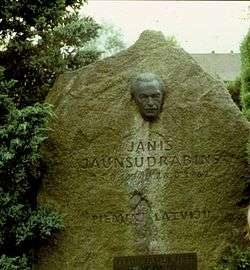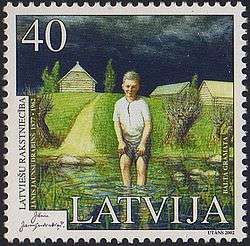Jānis Jaunsudrabiņš
Jānis Jaunsudrabiņš (Nereta, August 25, 1877 — Körbecke, August 25, 1962 ) — Latvian writer and painter. One of the most popular authors of the first Republic of Latvia between the two world wars.

Biography
In 1886–1892 attended Nereta school, 1892–1893 – Panemunis in Russian School, 1893–1895 taught at Nereta, 1895 – 1897. studied at the Vecsaté Agricultural School. In 1896 published the first short story Winter Night in the Latvian Aviation newspaper. In 1898 worked as an agricultural specialist in Remte, but was attracted to art, 1899–1903 studied at Blum School of Painting Riga. In 1905 three months of training Munich. 1908–1909 lived and studied art with his family Berlin, teacher Lovis Corinth. Returned lived in Milgravis, 1913 – 1915. – Pļaviņas, 1915–1918 – Caucasus. On his return he engaged in painting and writing. In 1924 traveled Europe with a grant from the Cultural Foundation. In 1937 divorced with his wife Sabile] Ilūkste. In 1944 retreated to the West.[1]
Works

He painted landscapes, portraits, illustrated books (including his own), wrote articles on art, including on M. K. Čiurlionis.
The story "The Frosty Rings" reveals the love drama of two young people. The experience of childhood is reflected in the "White Paper", the "Green Paper", and other collections. The prose has a strong tradition of psychological realism and neo-romanticism. The works subtly convey the spiritual experiences of the characters, depict the life of various strata of rural Latvia, emphasize human connection with nature, continuation of national traditions; Latvian motives abound. He has written pictures, short stories and poems, plays, books on Latvian emigration, and descriptions of Latvians in various countries. Translated into Latvian language works by K. Donelaitis, G. Landsbergis-Žemkalnis and P. Vaičiūnas.[2]
Legacy
In 1965 Jānis Jaunsudrabiņš Prose Prize (Latvian: Jāņa Jaunsudrabiņa prozas balva) was created.[3]
Bibliography
- Frosty Rings (Latvian: Veja ziedi ), 1907
- White Paper (Latvian: Balta grāmata), 1914
- Green Paper (Latvian: Zaļa grāmata ), 2 d. 1950 – 1951,
- Aija ( Latvian: Aija ), 1911, Echo (Latvian: Atbalss), 1914–1915, Winter (Latvian: Ziema), 1925 trilogy
- Dance of Death (Latvian: Nāves deja), novel, 1924
- The Newcomer and the Devil (Latvian: Jaunsaimnieks un velns), novel, 1933
- Don't Look at the Sun (Latvian: Neskaties saule), novel, 1936
- Capri (Latvian: Kapri), novel, 1939
- Money (Latvian: Nauda), novel, 1942
- Uršulytė (Latvian: Uršulīte), short story, 1929
- Without Homeland (Latvian: Bez dzimtenes), [1947
- I tell my wife (Latvian: Es stāstu savai sievai), 1951
- My Life (Latvian: Mana dzīve), 1957
References
- "Jānis Jaunsudrabiņš (1877–1962)". Vietas.lv. February 14, 2006. Archived from the original on March 14, 2016. Retrieved September 1, 2016.
- (in Latvian) Jānis Jaunsudrabiņš
- (in Latvian) JĀŅA JAUNSUDRABIŅA BALVAS FONDA STATŪTI